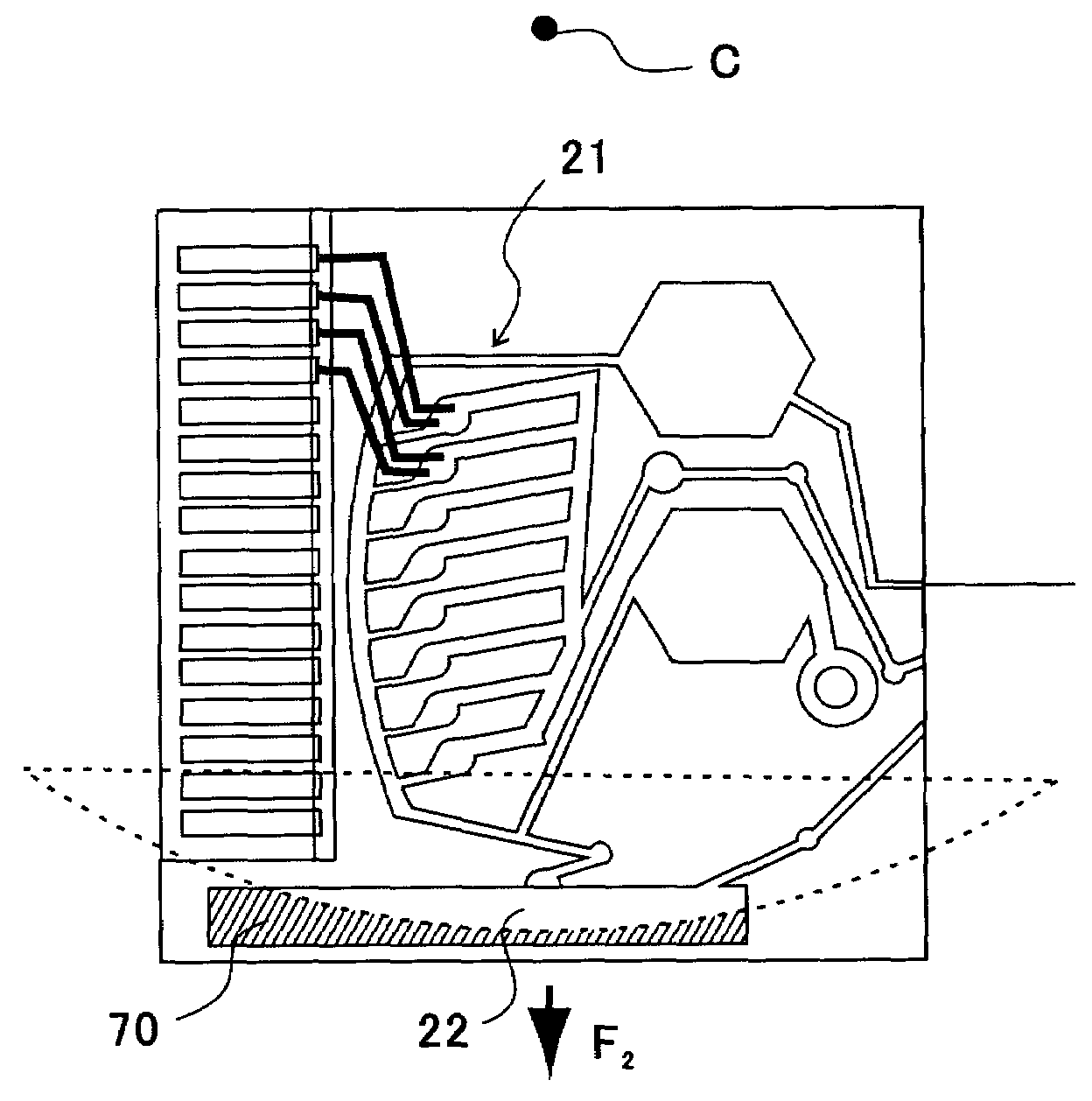Blood analysis device and blood analysis method
a technology of blood analysis and blood, which is applied in the direction of specific gravity measurement, laboratory glassware, instruments, etc., can solve the problems of fluctuation of the concentration of measured chemical substances and the cost of the device, and achieve the effect of smooth introduction
- Summary
- Abstract
- Description
- Claims
- Application Information
AI Technical Summary
Benefits of technology
Problems solved by technology
Method used
Image
Examples
first embodiment
[0056]FIG. 2 is a perspective view of a blood analysis device according to a first embodiment of the present invention, FIG. 3 is an exploded perspective view, FIG. 4 is a bottom plan view of an upper substrate, and FIG. 5 is a plan view of a lower substrate. In these figures, reference numeral 10 denotes a blood analysis device, and an upper substrate 12 is overlaid on a lower substrate 14. The upper and lower substrates 12, 14 are, for example, made of resins such as polyethylene terephthalate (PET) and polycarbonate (PC).
[0057]In a bottom surface of the upper substrate 12, as shown in FIG. 4, a calibrator solution reservoir 16 and a blood reservoir 18 are provided slightly nearer an upper side of the figure, a plasma separating section (sensor section) 21 is disposed beneath, and a calibrator solution waste reservoir 22 is laterally disposed. The plasma separating section (sensor section) 21 is provided with a plurality of sensor grooves 20, and each sensor groove 20 has an enlar...
second embodiment
[0078]FIG. 16 shows a blood analysis device according to a second embodiment of the present invention. This analysis device 10 is different from the first embodiment in that, as shown by slant lines in the figure, inner walls of a blood reservoir 18, an upstream blood introducing channel 24b, and an inlet port 40, and channel inner walls of a through hole 36 to a calibrator solution reservoir 16 are subjected to a hydrophilic treatment. Instead of a blood collecting needle, a blood collecting cylinder 76 is attached to the blood intake port 40. Another structure is the same as that of the first embodiment.
[0079]In the blood analysis device of the first embodiment, blood and calibrator solution can be conveyed utilizing a centrifugal force, but suction using a pump is required for collecting the blood from a person being tested. The second embodiment uses a capillary blood sampling device 76 for use in a blood sugar (glucose) value inspection performed by each person at home at prese...
example 1
[0084]A blood analysis device as shown in FIGS. 2, 3, was prepared and attempts were made to perform calibration of an electrochemical sensor, introduction of blood, separation of blood cells and plasma by centrifuge, and analysis of various chemical substance concentrations in plasma. Procedures of the device preparation have been substantially already described. In the blood analysis device used herein, a PET resin was used in a substrate, and a size thereof was a 20 mm square.
[0085]As to sensor electrodes, in FIG. 8, the respective sensor electrodes were disposed for analyzing glucose, pH, lactic acid, creatinine, sodium ion, potassium ion, calcium ion, and blood urea nitrogen (BUN) from left side in FIG. 8. As a calibrator solution, Dulbecco's phosphate buffer (PBS, 153.2 mM NaCl, 4.15 mM KCl, pH 7.4) was used with supplement of 1.0 mM CaCl2,4.0 mM glucose, 5.0 mM urea, 1.0 mM lactic acid, and 100 μM creatinine.
[0086]After introducing about 1 μL of calibrator solution into a cal...
PUM
| Property | Measurement | Unit |
|---|---|---|
| depth | aaaaa | aaaaa |
| thickness | aaaaa | aaaaa |
| thickness | aaaaa | aaaaa |
Abstract
Description
Claims
Application Information
 Login to View More
Login to View More - R&D
- Intellectual Property
- Life Sciences
- Materials
- Tech Scout
- Unparalleled Data Quality
- Higher Quality Content
- 60% Fewer Hallucinations
Browse by: Latest US Patents, China's latest patents, Technical Efficacy Thesaurus, Application Domain, Technology Topic, Popular Technical Reports.
© 2025 PatSnap. All rights reserved.Legal|Privacy policy|Modern Slavery Act Transparency Statement|Sitemap|About US| Contact US: help@patsnap.com



